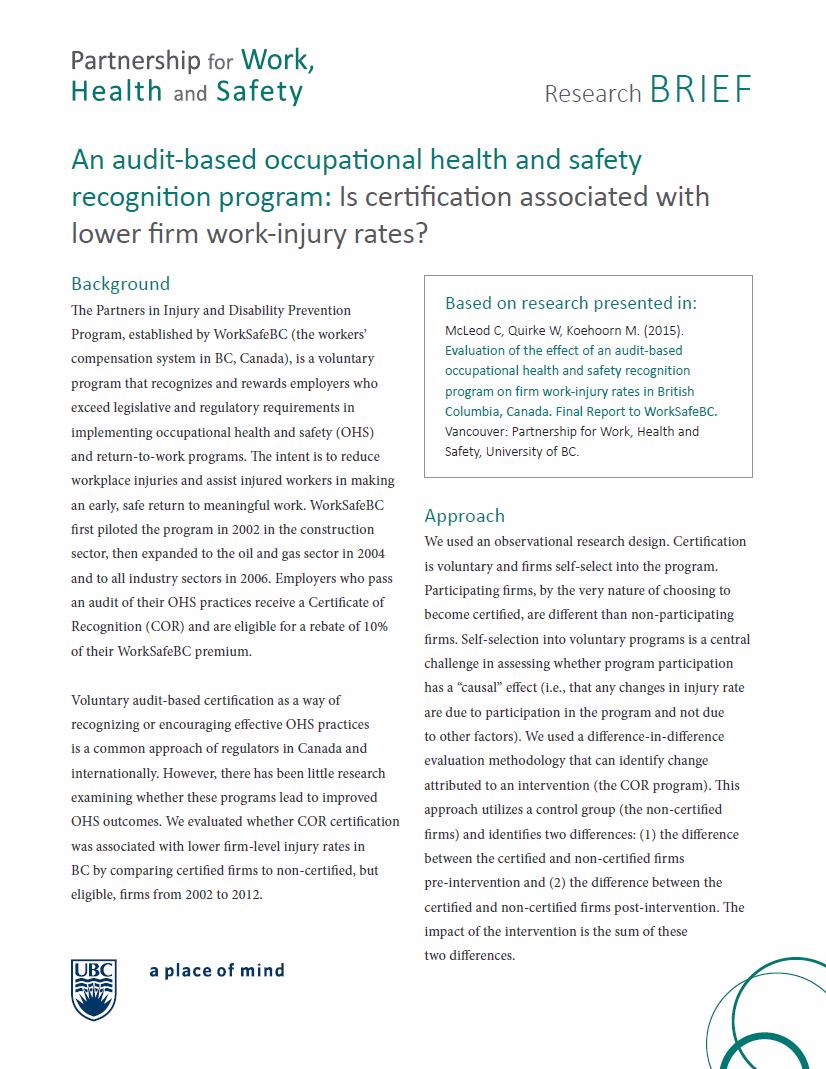In brief
- Health care workers are at risk for physical and verbal violence from those they provide care for, with higher rates of violence-related injuries compared to workers in other occupations.
- In BC, a provincial educational program, the Provincial Violence Prevention Curriculum (PVPC), has been rolled out to staff within most high and medium risk health care settings.
- This project used a realist approach to evaluate the PVPC education to identify explanations of how, why, and for whom the violence prevention education is effective in preventing violence and related injuries.
- More than 80 interviews and focus groups were held with 136 individuals across nine emergency departments in Island, Fraser, and Vancouver Coastal Health.
- Key findings include: Content specific to clinical areas and credible trainers using real stories increases learning and retention; relevant clinical content and a prevention focus increases confidence and awareness of risk; and a work environment that promotes physical safety, a cohesive team approach, and support during violence increases confidence to prevent and manage violence.
Detailed findings and recommendations
- A five-page research brief describes the methods, findings, and recommendations.
- A checklist of recommendations is available separately.
- A final report to WorkSafeBC and an article in the journal Healthcare are also available.
- Short videos focused on the findings and the recommendations are a quick way to learn about the project findings.
| Findings | Recommendations |
|---|---|
Frequently asked questions
Who conducted and funded the research?
The evaluation was funded by WorkSafeBC and conducted by researchers at the Partnership for Work, Health and Safety at the University of BC.
When and where was the evaluation done?
Interviews and focus groups were conducted between January and October 2019 in nine emergency departments: one rural, one community and one urban tertiary hospital in each of Fraser Health, Island Health and Vancouver Coastal Health.
Who participated?
Interviews were held with frontline emergency staff and focus groups were held with violence prevention educators, acute care leaders, and Joint Occupational Health and Safety (JOSH) Committee members. All participants were asked what influenced whether individuals learned and were able to apply violence prevention education and why.
How were people invited to participate?
Posters were placed in emergency departments at the research sites and individuals wishing to participate in an interview voluntarily contacted the research team. Potential focus group participants received an email and replied to the research team if they wished to participate.
Why did the project take so long?
The evaluation involved a large number of participants and sites, and analyzing and synthesizing over 3,500 pieces of data took a significant amount of time and work. The pandemic delayed sharing of the results by 6 months.
What is a realist evaluation?
This evaluation’s realist approach was developed in the United Kingdom where it is increasingly used in health research. For more information about realist evaluation please visit www.ramesesproject.org.
Related publications
An evaluation of violence prevention education in healthcare
Journal article
Provost S, MacPhee M, Daniels M, Naimi M, McLeod CB.
Safety Science. 2023 Mar;159(106011).
Realist evaluation of violence prevention education in British Columbia healthcare: How does it make a difference?
Thesis
Provost S.
Vancouver: The University of British Columbia; 2021.
A realist review of violence prevention education in healthcare
Journal article
Provost S, MacPhee M, Daniels MA, Naimi M, McLeod C.
Healthcare. 2021; 9(3):339.
Does it make a difference? Evaluating violence prevention education in BC healthcare
Research brief
Based on: Provost S, MacPhee M, Daniels M, McLeod C. Realist Evaluation of Violence Prevention Education in BC Healthcare. Final Report to WorkSafeBC. Vancouver, BC: Partnership for Work, Health and Safety; Dec. 2020.
Realist evaluation of violence prevention in BC healthcare
Report
Provost S, MacPhee M, Daniels M, McLeod C.
Vancouver, BC: Partnership for Work, Health and Safety; Dec. 2020.
Time to return to work following workplace violence among direct healthcare and social workers
Journal article
Choi K, Maas ET, Koehoorn M, McLeod CB.
Occupational and Environmental Medicine. 2020 Mar;77(3):160-167.
Risk of violence among healthcare staff and return-to-work outcomes
Thesis
Choi K.
Vancouver: The University of British Columbia; 2018.
Learn more about our other work on violence prevention in health care: Violence prevention programs in health care
Thank you to all of the people who have supported this work, including WorkSafeBC, Project Advisory Group members, content experts, interview and focus group participants, and clinical leaders and assistants who posted/shared information about the project and/or arranged meeting spaces. In this unusual time we hope you are all staying well and that together we remain kind, calm and safe.


